Madagascar, often described as a jewel in the Indian Ocean, boasts an intricate tapestry of climatic conditions that sculpt its enchanting ecosystems. Like a painter wielding a palette of vibrant hues, the island’s climate is influenced by a multitude of factors, resulting in an enticingly tropical and diverse environment. This climate is not merely a backdrop but a vital force, shaping the flora and fauna that populate the island, making it one of the most remarkable places on Earth.
The climate of Madagascar is primarily defined by two seasons: the wet season and the dry season. The wet season typically spans from November to April, heralded by the monsoon winds that sweep across the region, bringing along copious amounts of rainfall. During this time, the island transforms into a lush veritable paradise. Rivers swell with torrents, and the verdant forests pulse with life. It is as if the island breathes deeply, drawing in the moisture that sustains its myriad species.
In stark contrast, the dry season extends from May to October. The drenching rains retreat, and the landscape undergoes a metamorphosis, reminiscent of a chameleon adapting to its surroundings. This season is characterized by cooler temperatures and lower humidity, as the sun reigns supreme, casting long shadows over the terrain. While it may seem the vibrancy dims, the dry season brings its own beauty; the air is crisp, and the skies are often a brilliant azure, painting an inviting tableau for exploration.
Geography plays a critical role in the climate of Madagascar. This magnificent island is blessed with a variety of topographies and microclimates, each contributing uniquely to its overall character. The eastern coast, enveloped by the Eastern Rainforest Zone, is a lush corridor of biodiversity, fed by the warm moisture-laden winds sweeping in from the sea. Here, the forests are home to a symphony of species, from the enchanting lemurs to the diverse palisades of ferns and flowering plants. The rainforest acts as a sponge, capturing rainfall and nourishing the vibrant ecosystems that thrive within.
In contrast, the western expanses of Madagascar lead to the dry deciduous forests, where the flora has adapted to survive in less forgiving climatic conditions. The baobab trees, towering sentinels of the landscape, exhibit resilience and majesty, punctuating the horizon like ancient giants. Their silhouettes against the twilight sky become a metaphor for endurance, showcasing how life can flourish even when faced with adversity.
Central Madagascar presents a different climate tableau altogether, where the highlands experience a more temperate climate with cooler temperatures. This area, often shrouded in mist, provides a unique environment where biodiversity flourishes in the form of endemic species, showcasing the remarkable adaptability of life. The highlands are a realm of contrasts—here, the chilly nights beg for warmth, while the sun-drenched afternoons invite exploration and curiosity.
Despite its captivating landscapes and diverse climatic zones, Madagascar is not immune to the pernicious impacts of climate change. Rising temperatures and erratic weather patterns pose significant challenges to its delicate ecosystems. The island is witnessing an increase in the frequency and intensity of extreme weather events, such as cyclones and prolonged droughts. These climatic shifts threaten the intricate balance of life that has evolved over millions of years, pushing species to their limits and prompting urgent conservation efforts.
In-depth understanding of Madagascar’s climate is crucial for conservationists, enthusiasts, and policy-makers alike. The island’s unique appeal lies not only in its breathtaking vistas but also in the intricate interconnections between its climate and ecological integrity. Protecting and preserving this delicate balance is imperative as climate change continues to rear its disruptive head. Adaptive measures that bolster resilience and sustainability are essential for both local communities reliant on agriculture and the diverse wildlife that calls Madagascar home.
Engagement with local populations is paramount when discussing climate initiatives. The people of Madagascar possess a wealth of knowledge about their environment, cultivated over generations. By fostering collaborative approaches that incorporate traditional practices and modern scientific insights, effective strategies can be developed to mitigate the adverse effects of climate change on both human and ecological systems.
Ultimately, the climate of Madagascar is a compelling narrative interwoven with tales of elegance, resilience, and transformation. It serves as a reminder of our interdependence with nature, urging a collective commitment to protection and stewardship. The captivating landscapes, teeming with life, remind all who observe them that the fight against climate change is not only necessary—it is imbued with the potential for harmony, renewal, and enduring beauty.
As stewards of our planet, we are called to champion the unique climates and ecosystems that define places like Madagascar. The island’s distinctive environment encapsulates a wealth of wisdom and diversity that resonates across borders. Each droplet of rain that nourishes its forests and every gust of wind that dances through its highlands tells a story of life, struggle, and the potential for sustainable futures. In understanding and advocating for Madagascar’s diverse climates, we not only preserve an irreplaceable piece of our world but also ensure a legacy of respect for nature in the face of climate change.







